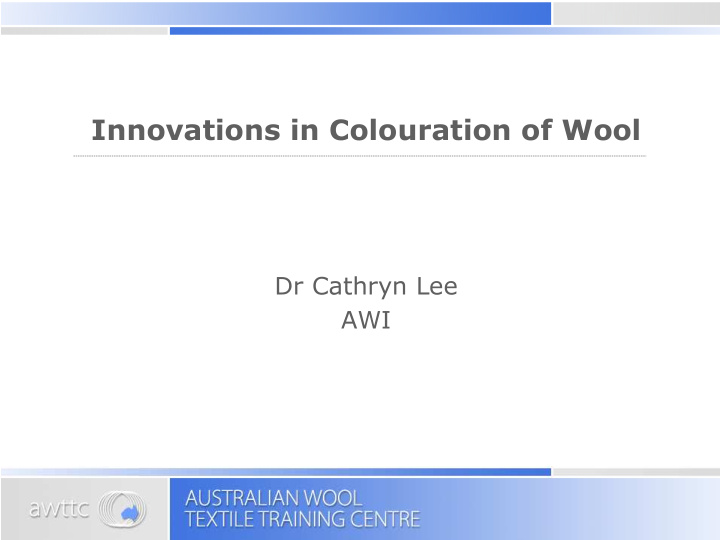



Innovations in Colouration of Wool Dr Cathryn Lee AWI
Technologies Superwhite Improved bleaching and whitening technologies can achieve the whiteness and brightness of bleached and whitened cotton. “Mercerised” wool A misnomer used to describe the shiny appearance of wool treated in the soft lustre process to create a lustrous fibre with a ‘silk-like’ appearance
Superwhite The Problem-Opportunity The consumer has become § accustomed to the bright white products manufactured from cotton and synthetics Wool has a natural cream colour § so must be bleached while minimising damage Wool treated with Fluorescent § Whitening Agents (OBA’s) yellows rapidly in sunlight, especially when wet.
Rapid Photo-yellowing
Superwhite The Technical Challenges § To bleach wool and wool-blend fabrics to a better white with minimal damage § To prevent rapid photo-yellowing of the optically brightened wool-containing fabric
Superwhite Pure Wool The Technical Solution § An improved bleaching process for the wool § Colourclear WB (Rohm & Haas) § A process that ensures that the contact between the OBA and the wool is minimised § Don’t use Optical Brightening Agents (or when absolutely necessary minimise their use)
Wool Bleaching § Oxidative bleach § Hydrogen peroxide plus stabiliser § Reductive bleach § Hydrosulphite (Blankit IN) § Thiourea dioxide § Colourclear WB § Combined Oxidative-reductive bleach
Bleaching – Oxidative step
Bleaching - Reductive Step
Samples Stabilised Peroxide Stabilised Peroxide + Stabilised Peroxide + + hydros Colorclear WB Colorclear WB
Technical data CIE Whiteness Index Untreated wool -4 Oxidatively bleached 20 Combination bleach 54 Unbleached Blend 38 Bleached, Whitened Blend 133 Whitened Polyester 150
Superwhite Blends The Technical Challenges § To bleach wool and wool-blend fabrics to a better white with minimal damage § Oxidative-reductive bleach using Colourclear WB § To prevent rapid photo-yellowing of the brightened wool- containing fabric § The use of an application method that ensures the OBA goes onto the synthetic fibres in the blend and not the wool
Application Method § Dye blend with OBA that has properties of a disperse dye (i.e. poor affinity for wool) THEN § Bleach the wool – the bleaching process will also strip the OBA from the wool fibre
Superwhite – Wool/PET
Superwhite – Wool/Acrylic
Superwhite – The Outcome Whitened Polyester = 140
‘Mercerised' Wool (Soft-Lustre Wool) The Problem-Opportunity § There is a market for wool products that will rival cashmere in appearance and handle § To capture that market wool needs a softer handle and greater lustre
‘Mercerised' Wool The Technical Challenges § To smooth out the scales so that the fibre has enhanced lustre. § To ensure that the modified surface of the fibre does not impair the handle of the fibre or wool products
The Wool Fibre Diagram courtesy of CSIRO
‘Mercerised' Wool The Technical Solution § High level chlorination to smooth out the scales § Application of a (silicone) softener to remove the ‘scroopy’ handle imparted § The scroopy handle is derived from the high friction of the exposed protein on the fibre surface
‘Mercerised' Wool – The Process Application of 3.5-4.5% § chlorine on weight of wool at pH= 1.5-2.0 Antichlor with sodium § metabisulphite Neutralise and remove § degraded protein pH=9.5-10 Efficiently rinse § Re-acidify § Application of a micro- § silicone softener (eg CT80 – Wacker) Dry §
The Equipment
Equipment The minimum requirements § a six-bowl suction drum backwashing line § a suction drum drier of adequate capacity. § a chemical supply station featuring § stock tanks, § making up facilities and § flow monitoring devices § automatic pH control facilities for the anti-chlorination, protein strip and rinse bowls.
Processing conditions The main potential problems Re-combing & Gilling § likely to be encountered Sliver less cohesive, § recombing using stuffer box when processing Soft Lustre or cohesive lubricant treated wool are associated recommended. with the following: Roving & Spinning § Very low fibre cohesion § Rubbed rovings use higher § Reduced tendency to re- § level of rubs absorb moisture Antistat (Disperstat IP) § Loss of the imparted § required handle. Normal yarn twists § Steam below 80C §
Dyeing & Finishing ‘Mercerised' wool: All dyes usable, reactives § recommended Dyes have a higher strike rate § Evenness depends on the evenness of § the chlorination as well as dyeing conditions May be necessary to pre-neutralise § the fibres Softer yarn packages recommended § Fabric inherently machine washable §
‘Mercerised' Wool – The Outcome Outcomes § Equivalent handle to fibre 2um finer § Some diameter reduction § Softer handle, effect of softener § Higher lustre – silk like finish § Scales ‘smoothed’ § Machine washable garments
Samples
Partners § Partners for ‘Mercerised' Zhe Jiang Xin Ao Textiles Group Co.,Ltd Milos Knitwear (International) Ltd. Wool’ Babylan Yarns (Suzhou) Co. Ltd. CRYSTAL SWEATER LTD
Recommend
More recommend